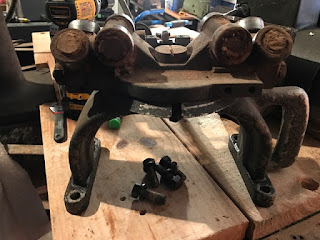There is a pin and set screw holding the handle assembly to the shaft. The table has a lot of bad spots, its going to be a lot of work to get that in good shape. I ordered a new badge for the front, the current one is beyond cleaning and repair.
Here are the replacement badges I had to have made so far for this machine.
The red badge is from the motor housing and the AC badge is for the magnetic starter box.
The other end of the shaft the handle assembly is mounted to, has a bolt securing it. The bolt also has a spring clip that must be removed before the nut can come off. The gear unit comes right off after removing the three cap head screws that hold it to the housing under the column. The unit and shaft should come off together. What a royal mess that was inside! Clearly no one that owned any of the saws I've acquired ever read Jon Eakes's book on radial arm saws, because no one ever kept any of those machines clean. That housing is full of grease laden sawdust.
There are three cap head screws that hold the column housing to the underside of the column base.
They are very tough to get to as they are recessed and its a tight fit from the frame to the side of the column housing. You will need a socket with a 5/16 Allen head and a 12 or 18" extension, you need a long reach from the underside of the table to reach the heads. I used that combination in my DeWalt impact driver on its slowest setting, they came right out. The housing slips right off.
Removing the column base using isn't all that difficult but accessing the bolts on the underside is a bit cumbersome , the same as the prior procedure. I had to use a 24" breaker bar with a 7/8" socket to hold those bolts while my nephew ratcheted off the bolts from the top of the column base. The other two are slotted flat head bolts, but their nuts are 1 1/16".
Once the hardware is all removed you can remove the base and column. Lay it on a table as you have to remove the bushing and the elevating shaft from the bottom of the column. The bushing is secured by four bolts which bolt directly into the bottom of the column ring. You can see the four mounting holes for those bolts in the picture below.
The housing, the lower gear cover and the bracket are all going to have top be thoroughly cleaned, sanded, media blasted and painted.
EDIT: Bradley Tools & Fasteners of Johnston, IA bought out the DeWalt radial arm saw parts inventory. I was able to get the elevating screw, the cap, the thrust bearing for that screw and the dog screw for the king bolt through them.
I cleaned all the hardware and gear from the end of the elevating screw as they were crudded up with greasy sawdust.
The bushing was all full of that greasy sawdust too but that cleaned up rather easily. Would it be too much if I polished it with brass polish? Here it is just cleaned with Scotch-Brite. As you may know, brass looks like cast iron until it is machined, you can see the difference as the important parts are machined, the rest are raw.
There is also a bearing on the elevating shaft, this one HAS to be original; I've never heard of the Nice Ball Bearing Company, have you?
It will probably be tough to find that new. If I can't I'll have to clean and re-grease it. I hate doing that.
EDIT: See my edit above about where to source this bearing.
I cannot get the column to come out of the base. It is cold in the garage, so I'm assuming that has something to do with it. I used Kroil in the keyway and the edge where the column meets the base, we will see if that frees it up other wise I'll have to try heating the base.
It is time to finish paint removal and media blasting for the parts that require it from the base and arm assembly. Doing a full restoration requires a lot of painting and prep work. Fortunately, last year I found a brand new,unused, Grizzly 48" sand blast cabinet on craigslist for 25% of its retail cost. It has paid for itself many times over.
Part 6 will round-out the base and column (assuming I can get the darn column out of the base!) and go over the arm and carriage assembly. I'm also hoping to complete Part 4A, wiring the motor up to the starter for testing soon as well.




















































